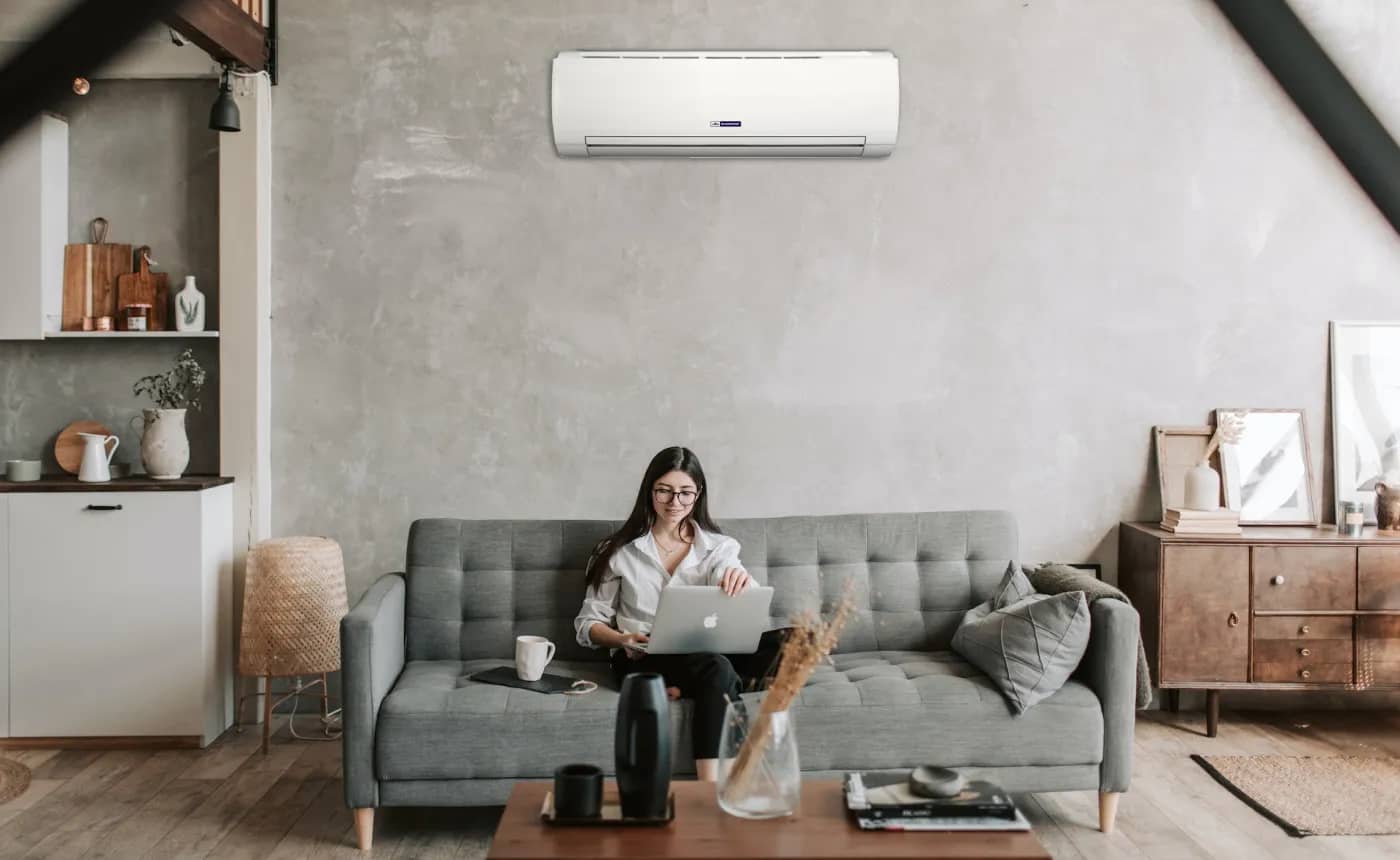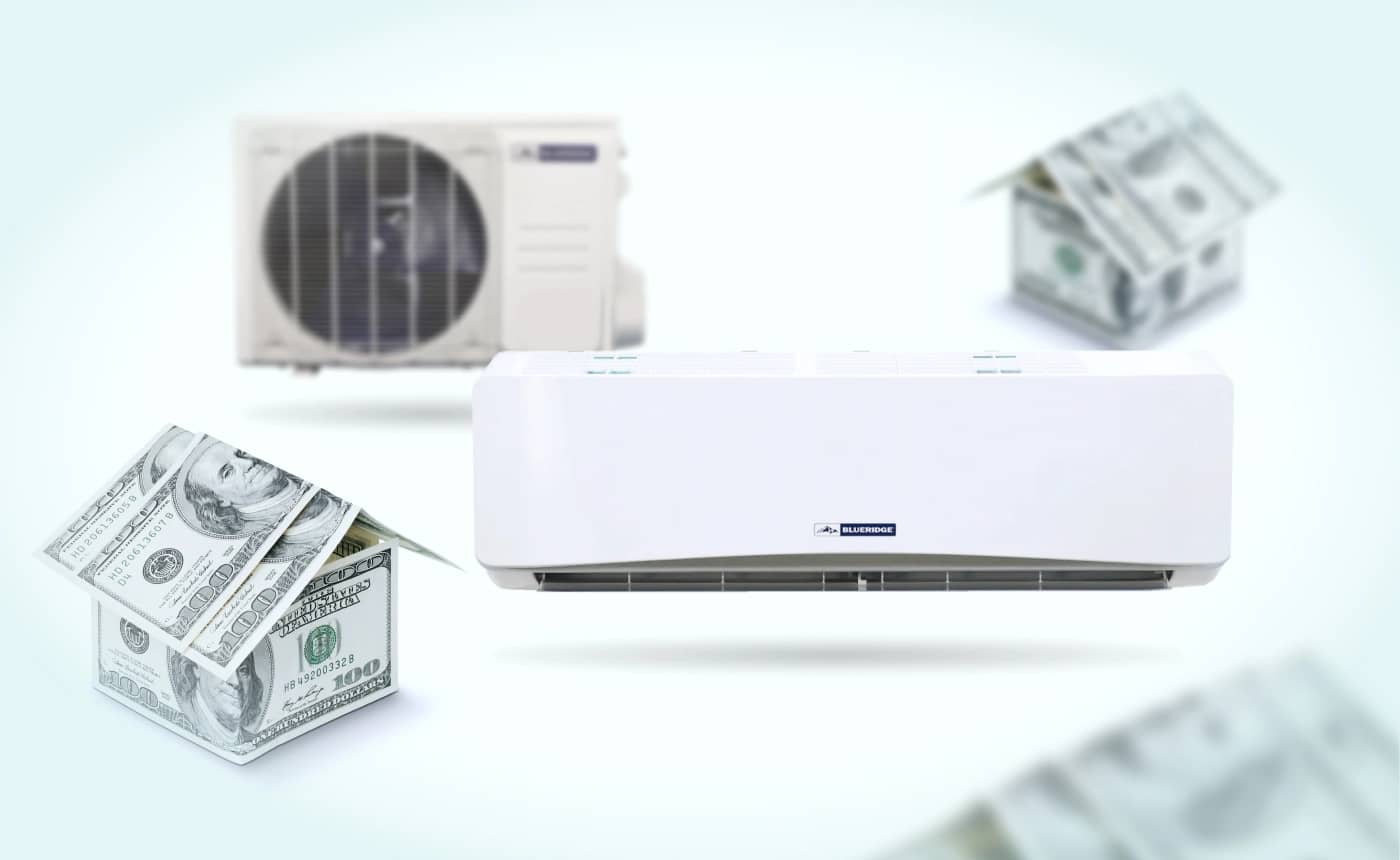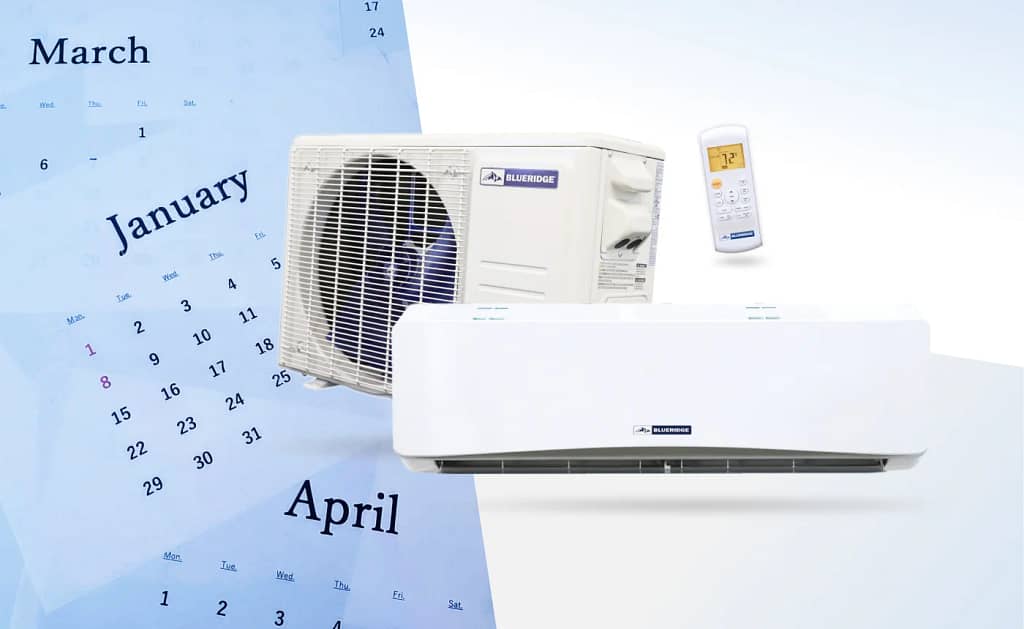
There’s nothing better than having a reliable heating and cooling system when you need it most. Those hot, scorching summer days? A strong and efficient air conditioning system will make a huge difference in your comfort. How about those frigid winter nights? A dependable heating system ensures your home remains cozy and warm, even when the temperature drops. Enter the mini-split heating and cooling system–the perfect solution for year-round comfort. Find out how a mini split system heats and cools and decide whether it is the right choice for your home.

Whether battling the sweltering heat or the bone-chilling cold, a reliable heating and cooling system is essential.
KEY TAKEAWAYS
- Mini-split heating and cooling systems provide versatile year-round comfort for your home.
- With multiple zoning options, a ductless mini-split system can help eradicate the thermostat wars and leave everyone satisfied.
- Each season requires specific maintenance and care to optimize system performance.
- Ductless mini-splits are more environmentally friendly than traditional air conditioning systems and will decrease your carbon footprint and energy expenses.
- Alpine Home Air offers support and resources to help you make the most of your mini-split system throughout the year.
Having a reliable cooling and heating system is about more than efficiency. It’s also about creating spaces where we can relax, work, and spend time with loved ones without being affected by extreme temperatures.
With a dependable heating and cooling system, you can confidently face scorching summer days, knowing you have a refuge of cool, refreshing air.
And when winter’s icy grip takes hold, you can rest easy, knowing that your system will keep your home warm and inviting.
Investing in the right system, like a well-sized and efficient mini-split, ensures you won’t have to worry about uncomfortable extremes. It’s a reliable companion that offers comfort no matter the season.

Does a Mini Split Heat and Cool?
Unlike the typical central forced air systems we see in most homes and buildings today, ductless mini-split systems offer cooling and heating capabilities with no ductwork needed, making them a comprehensive solution for maintaining indoor comfort throughout the year.
Mini-Split System Components
Mini-split systems consist of two primary components: one or more indoor units called air handlers and an outdoor unit called a condenser or heat pump.
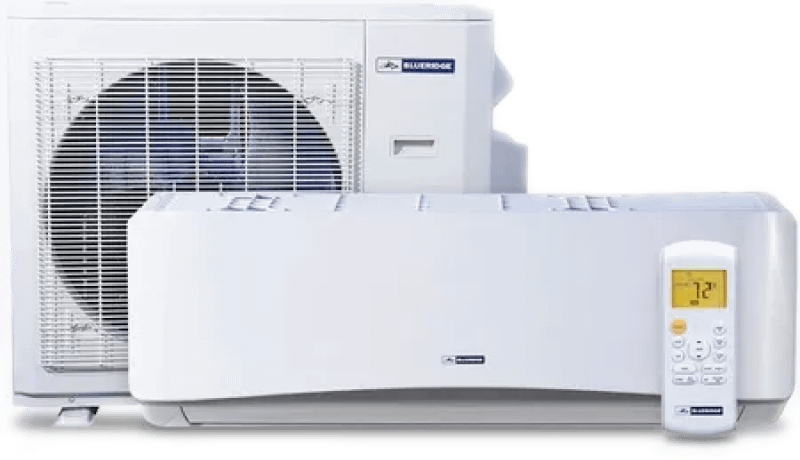
The indoor unit disperses conditioned air into the room, while the outdoor unit facilitates the heat exchange.
These two units connect via conduit lines that house the power cable, refrigerant tubing, suction tube, and condensate drain.
They are managed with remote control and are often WiFi-capable, allowing you to control your system from just about anywhere.
Unlike conventional central forced air systems that frequently cycle on and off to maintain the desired temperature, inverter-driven compressors operate continuously but adjust their speed based on indoor cooling or heating needs and fluctuations in the outdoor environment.
Mini-Splits and Heat Transfer
The working principle of a ductless mini-split revolves around the transfer of heat.
When it’s in cooling mode, the system extracts heat from the indoor air and expels it outside.
Conversely, when the ductless mini-split is in heating mode, the system extracts heat from the outside air (even in frigid conditions) and uses it to warm the indoor space.

Heat transfer gives the ductless mini-split a unique advantage over traditional HVAC systems. Central systems typically require separate units for heating and cooling, often leading to increased energy consumption and higher operational costs.
Not only that, but traditional heating and cooling systems also require ductwork to distribute conditioned air throughout a building.
Ductwork can lead to energy inefficiency in central AC, creating increased installation complexities and the need for regular duct maintenance.
How Do Mini-Splits Heat and Cool?
Central to the dual functionality of mini-splits is inverter compressor technology.
While traditional HVAC compressors operate at a fixed speed, turning on and off to maintain the desired temperature, inverter compressors adjust their speed dynamically based on current needs.
This ensures not only more precise temperature control but also greater energy efficiency.
When heating is required, the system reverses its operation, drawing heat from the outside and transferring it indoors.

One important thing to note is that a mini-split system can not heat and cool simultaneously.
Ductless mini-splits run in one mode at a time–either heat or cool–and multi-zone systems cannot heat one zone while cooling another.
Mini Split Heating Mode
When you set your mini-split system to heating mode, the outdoor unit extracts heat from the outside air, even in cold weather. The refrigerant inside the outdoor unit absorbs this heat and evaporates, transforming it into a gas.

Subsequently, the compressor in the outdoor unit increases the pressure of the refrigerant gas, raising its temperature significantly.
Then, the hot, high-pressure gas is pumped to the indoor unit(s) through refrigerant lines. Here, the refrigerant releases the absorbed heat as it condenses back into a liquid.
The warm air generated during this heat exchange process is distributed into your living space by the indoor fan, elevating the indoor temperature to your desired level.
Mini Split Cooling Mode
In cooling mode, a mini-split heat pump operates by efficiently removing heat from the inside of your living or working space and releasing it outside.

Inside the indoor air-handling unit is an evaporator coil and a fan. This fan circulates warm indoor air over the evaporator coil.
As the warm indoor air passes over the evaporator coil, the refrigerant inside the coil absorbs heat. This heat exchange causes the refrigerant to evaporate, transforming from a liquid into a gas.
The now-hot, high-pressure refrigerant gas is pumped through the outdoor condenser coil. In this coil, the refrigerant releases the heat absorbed from the indoor air into the outdoor environment. As the refrigerant cools down, it condenses back into a liquid state.
This cooling process effectively lowers the indoor air temperature, creating a comfortable and cooler environment within your living or working space.
The Joy of a Mini-Split Heat and Cool: Season by Season Maintenance
Though seasonal temperature changes can be challenging, a ductless mini-split system makes it easier to enjoy year-round comfort without compromise.
This versatile heating and cooling solution adapts seamlessly to the shifting demands of each season, ensuring that your home or workspace remains the perfect haven of comfort, no matter what Mother Nature has in store.
Fall: Getting Ready for the Chill
Fall is a transitional season that shifts from warm to cooler temperatures.
Ductless mini-split systems excel during the fall as they seamlessly adapt to changing climate needs during this time.
These systems can easily go back and forth between efficient heating and cooling, making them perfect for maintaining a comfortable environment in a season when temperatures can fluctuate wildly from week to week and between day and night.
Note: mini-split AC and heat systems are designed to heat and cool but can’t do both simultaneously. For example, in a multi-zone system, you can’t simultaneously put one indoor unit on cooling mode and another on heating mode.
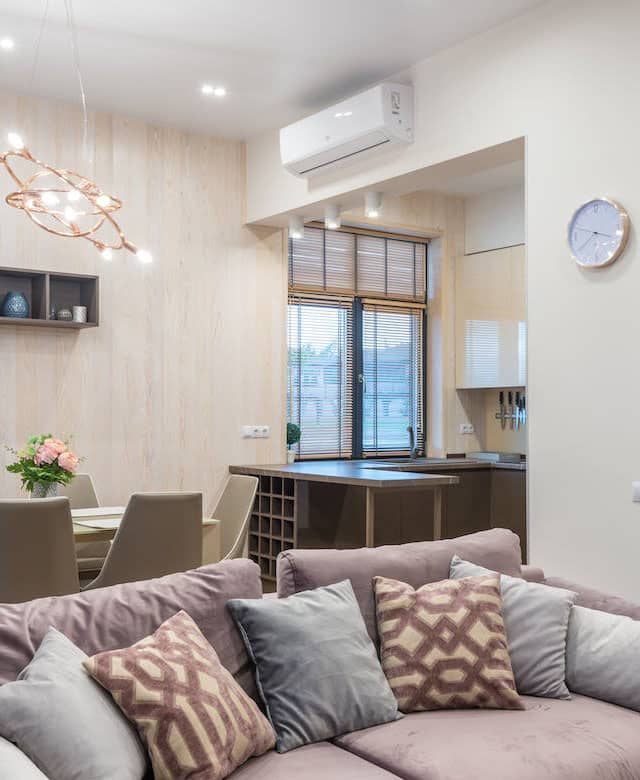
Preparing Your Mini-Split for Winter
Fall is a good time to do essential maintenance work on your mini-split to ensure it’s ready for the cooler months ahead.
- Clean or Replace Air Filters: Dirty filters can impede airflow and reduce heating efficiency. Clean or replace your mini-split air filters to maintain optimal performance.
- Check for Debris: Examine the outdoor unit for debris such as leaves, twigs, or dirt. Clear any obstructions around the unit to prevent airflow restrictions.
- Inspect Insulation: Ensure that your home or workspace is adequately insulated. Proper insulation helps retain heat and minimizes energy loss, allowing your mini-split to work more efficiently.
- Seal Drafts: Identify and seal any drafts or gaps around windows and doors. This will prevent warm air from escaping and cold air from entering, reducing the workload on your mini-split.
- Schedule Professional Maintenance: Consider scheduling an annual maintenance check with an HVAC professional. They can thoroughly inspect the system and address potential issues, ensuring your mini-split operates efficiently throughout the colder months.
Winter: Staying Warm and Cozy

When temperatures drop, and winter arrives, mini-split AC and heat systems again prove their versatility by providing efficient and reliable heating.
Unlike traditional heating systems that can take a while to warm up, mini-splits offer rapid and consistent heating.
These systems use heat pump technology to extract heat from the outside air, even in cold weather, making them a great choice for staying warm and cozy throughout the winter.
Not only that, but they are so energy efficient that your heating bills will also be more comfortable!
Maintenance Steps for Efficient Winter Heating
To ensure your mini-split operates at its best during the winter months, consider the following maintenance steps:
- Regular Filter Cleaning or Replacement: Clean or replace air filters monthly as in other seasons. This practice ensures proper airflow and indoor air quality.
- Check for Outdoor Unit Icing: During freezing conditions, inspect the outdoor unit for ice buildup. If ice accumulates on the unit, it can affect performance. De-icing may be required.
- Inspect the Condenser Coil: Snow and ice can accumulate on the condenser coil during winter storms. Clear any obstructions to maintain efficient heat exchange.
- Maintain Adequate Clearance: Ensure there is adequate clearance around the outdoor unit. Remove any snow, ice, or debris to avoid airflow restrictions.
- Monitor Thermostat Settings: Adjust your thermostat settings to meet your heating needs. Programmable thermostats can help you maintain comfort while saving energy.
Spring: Preparing for the Heat
As winter fades and the temperatures begin to rise, ductless mini-split AC and heat systems seamlessly transition from heating to cooling mode.
This flexibility is one of their key advantages, ensuring you stay comfortable as the seasons change.

With the ability to provide efficient heating and cooling, mini-splits are a reliable solution for keeping comfortable during seasonal changes, when your days may start chilly but warm up by the afternoon.
Preparing Your Mini-Split for Summer
Preparing your mini-split for the transition from winter to summer involves a few key maintenance steps:
- Inspect the Outdoor Unit: As the weather warms, examine the outdoor unit for debris or obstructions. Clear away leaves, twigs, and debris that might have accumulated during the winter.
- Check the Indoor Unit: Ensure the indoor unit is clean and dust-free. Clean or replace the air filters to maintain optimal airflow and indoor air quality.
- Calibrate Thermostat Settings: Adjust your thermostat settings to switch from heating to cooling mode. A programmable thermostat can help you set a comfortable and energy-efficient temperature schedule.
- Inspect for Leaks and Blockages: Check the refrigerant lines and drain pipes for leaks or blockages that might have happened during the winter months.

Summer: Keeping Cool and Saving Energy
Summer is one of the most favorable seasons for ductless mini-split systems due to their exceptional cooling capabilities.

These systems excel at maintaining comfortable indoor temperatures even during sweltering summer nights and August heatwaves.
Mini-split AC and heat systems provide precise cooling control, allowing you to create a comfortable living environment while also saving on energy costs.
Maintenance Steps for Peak Summer Performance
To ensure your mini-split operates at its best during the summer months, consider these maintenance tips:
- Clean the Air Filters: Dirty filters obstruct airflow and reduce cooling efficiency. Clean or replace the filters regularly, typically every 1 to 3 months, depending on usage and local air quality.
- Inspect and Clean the Indoor Unit: Dust and debris can accumulate on the indoor unit’s components. Gently clean the unit’s interior to maintain optimal cooling efficiency.
- Clean the Outdoor Unit: Ensure the outdoor unit remains free from debris, such as leaves, grass, and dirt. A clean unit allows for better heat exchange and cooling performance.
- Check for Refrigerant Leaks: Schedule a professional inspection to verify that the refrigerant levels are correct and there are no leaks in the system. Proper refrigerant levels are essential for cooling efficiency.
- Seal Any Air Leaks: Check for any air leaks around windows and doors and seal them. Proper insulation and sealing contribute to maintaining a consistent indoor temperature and reducing energy consumption.
- Adjust Thermostat Settings: Set your thermostat to an energy-efficient temperature during the hottest hours of the day. Consider using programmable or smart thermostats to create cooling schedules.
- Consider Shading: Providing shade for the outdoor unit will improve its efficiency by reducing the load on the system.
Mini-Split Heat and Cool Advantages
Unlike more traditional central forced air systems, these unique ductless mini-split systems offer several advantages, thanks to their unique heat pump technology:

Zoned Comfort:
Ductless mini-split heat pumps allow you to create different temperature zones within your home or office. Control each indoor unit independently, providing customized comfort to each space. This zoning capability helps you save energy by only conditioning the rooms you’re using.

Energy Efficiency:
Mini-split heat pumps are renowned for their energy efficiency. They use advanced inverter technology to adjust compressor speed based on the heating or cooling demand. This avoids the energy spikes associated with traditional systems that frequently turn on and off.

Flexibility in Installation:
The absence of ductwork makes mini-split heat pumps versatile. Install indoor units in various locations, from walls and ceilings to floors and concealed spaces. This flexibility in placement ensures minimal disruption to your interior design.

No Duct Losses:
Traditional ducted systems can lose a significant amount of conditioned air through leaks and uninsulated ducts. Mini-split heat pumps eliminate this issue by delivering conditioned air directly to the room, reducing energy wastage.

Year-Round Operation:
Mini-split heat pumps function efficiently in hot and cold climates. They can provide cooling during scorching summers and heating during chilly winters, ensuring year-round comfort.

Improved Indoor Air Quality:
Many mini-split systems have advanced filtration features, like multi-stage filters and ionizers, which help purify the air by capturing dust, allergens, and pollutants. This contributes to a healthier indoor environment.

Quiet Operation:
Mini-split systems are known for their quiet operation. The indoor units produce minimal noise, creating a peaceful living or working environment.

Cost Savings:
A ductless mini-split heat pump’s energy savings and reduced maintenance costs will be substantial over time, making these systems cost-effective.
How Much Does a Mini-Split Heat and Cool System Cost?
Investing in a mini-split heat and air system is more than just purchasing a piece of equipment; it’s about enhancing your home’s comfort and energy efficiency.
When considering such an investment, understanding the costs involved, both immediate and long-term, becomes paramount.

Initial Costs Can Vary
Drawing on data from a recent Forbes Home article, the cost of a typical mini-split system (including the system itself and the labor to install it) ranges between $2,000 and $14,500, with an average of $3,000.
This wide range arises from various factors.
For instance, the size of your home directly influences the mini-split’s capacity and the number of zones required. Not only that, but brand choices can affect price variations and the intricacies involved in the installation process.

Another factor in the price of a mini-split is local labor rates, which can add to your initial expenditure.
But despite all these variables, most homeowners who invest in a mini-split say the costs were well worth the benefits.
Lower Long-Term Operational Costs
When comparing the operational costs, mini-split systems frequently outpace traditional HVAC systems.
Why?
It comes down to the increased energy efficiency that a mini split’s design allows.

Unlike traditional HVAC systems that rely on extensive ductwork, mini-splits deliver conditioned air directly to specific zones or rooms.
This minimizes energy loss associated with ducts, where air can escape or lose its temperature as it travels through the system.
Mini-Splits Use Inverter Technology
The star of the mini-split system may be its variable speed inverter-compressor. Instead of the on-and-off operation of traditional systems, a mini-split adjusts its output to match heating or cooling demands. In this way, mini-splits avoid the energy-intensive start-up and shut-down cycles. As a result, the system consumes only the energy it needs, ensuring optimal efficiency.

The design of a mini-split, coupled with its cutting-edge technology, creates an environment of efficient energy usage.
Over time, this translates into reduced utility bills a
Are You Interested in Learning More? Reach Out to Alpine Today
Whether you are ready to purchase your first mini-split heat and air system or still have questions, our qualified and friendly Alpine Home Air team will help you navigate your next move.
From our excellent customer service team to our highly trained HVAC experts and even our informational Learning Center, you can find various ways to ensure you know exactly what you’re signing up for when purchasing one of our Blueridge mini-split systems.
If you’re ready to see what comfort and low cost can look like, join the Alpine family today!

